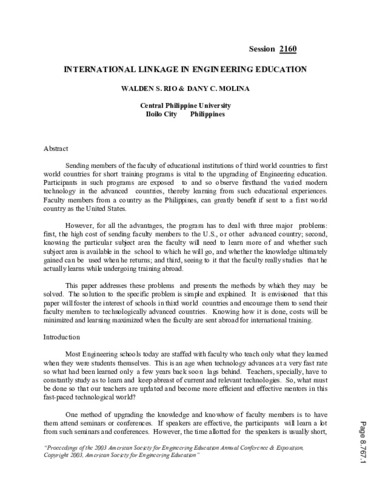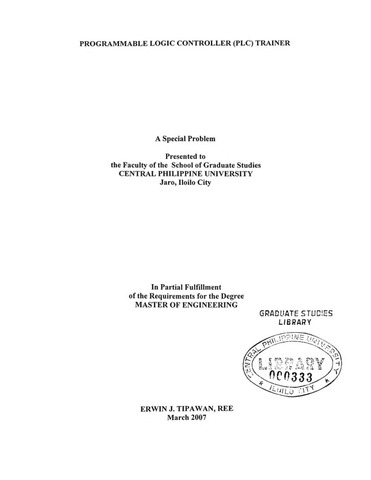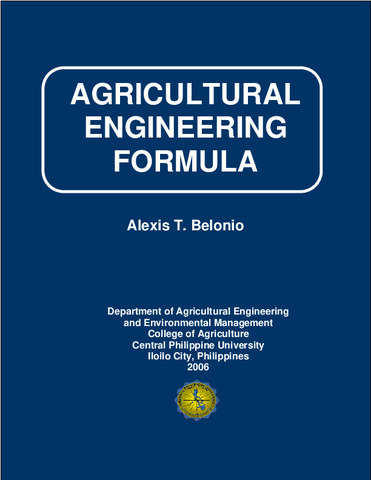International linkage in engineering education
| dc.contributor.author | Rio, Walden S. | |
| dc.contributor.author | Molina, Dany C. | |
| dc.date.accessioned | 2021-12-15T04:12:11Z | |
| dc.date.available | 2021-12-15T04:12:11Z | |
| dc.date.issued | 2003-06-22 | |
| dc.identifier.citation | Rio, W.S. and Molina, D. C. (2003). International linkage in engineering education. In Proceedings of the 2003 American Society for Engineering Education Annual Conference & Exposition. Washington DC: American Society for Engineering Education. | en_US |
| dc.identifier.issn | 2153-5965 | |
| dc.identifier.uri | https://hdl.handle.net/20.500.12852/1807 | |
| dc.description | Conference paper | en_US |
| dc.description.abstract | Sending members of the faculty of educational institutions of third world countries to first world countries for short training programs is vital to the upgrading of Engineering education. Participants in such programs are exposed to and so observe firsthand the varied modern technology in the advanced countries, thereby learning from such educational experiences. Faculty members from a country as the Philippines, can greatly benefit if sent to a first world country as the United States. However, for all the advantages, the program has to deal with three major problems: first, the high cost of sending faculty members to the U.S., or other advanced country; second, knowing the particular subject area the faculty will need to learn more of and whether such subject area is available in the school to which he will go, and whether the knowledge ultimately gained can be used when he returns; and third, seeing to it that the faculty really studies that he actually learns while undergoing training abroad. This paper addresses these problems and presents the methods by which they may be solved. The solution to the specific problem is simple and explained. It is envisioned that this paper will foster the interest of schools in third world countries and encourage them to send their faculty members to technologically advanced countries. Knowing how it is done, costs will be minimized and learning maximized when the faculty are sent abroad for international training. | en_US |
| dc.language.iso | en | en_US |
| dc.publisher | American Society for Engineering Education | en_US |
| dc.relation.uri | https://peer.asee.org/international-linkage-in-engineering-education.pdf | en_US |
| dc.subject.lcsh | Engineering--Study and teaching | en_US |
| dc.subject.lcsh | Engineering--Study and teaching (Continuing education) | en_US |
| dc.subject.lcsh | Engineering teachers--Training of | en_US |
| dc.subject.lcsh | Continuing education | en_US |
| dc.subject.lcsh | Engineering teachers--Education (Continuing education) | en_US |
| dc.subject.lcsh | Interorganizational relations | en_US |
| dc.subject.lcsh | Engineering schools--International cooperation | en |
| dc.subject.lcsh | International cooperation | en |
| dc.title | International linkage in engineering education | en_US |
| dc.type | Conference paper | en_US |
| dc.citation.firstpage | 8.767.1 | en_US |
| dc.citation.lastpage | 8.767.7 | en_US |
| dc.identifier.doi | 10.18260/1-2--12545 | |
| dc.citation.conferencetitle | Proceedings of the 2003 American Society for Engineering Education Annual Conference & Exposition | en_US |





